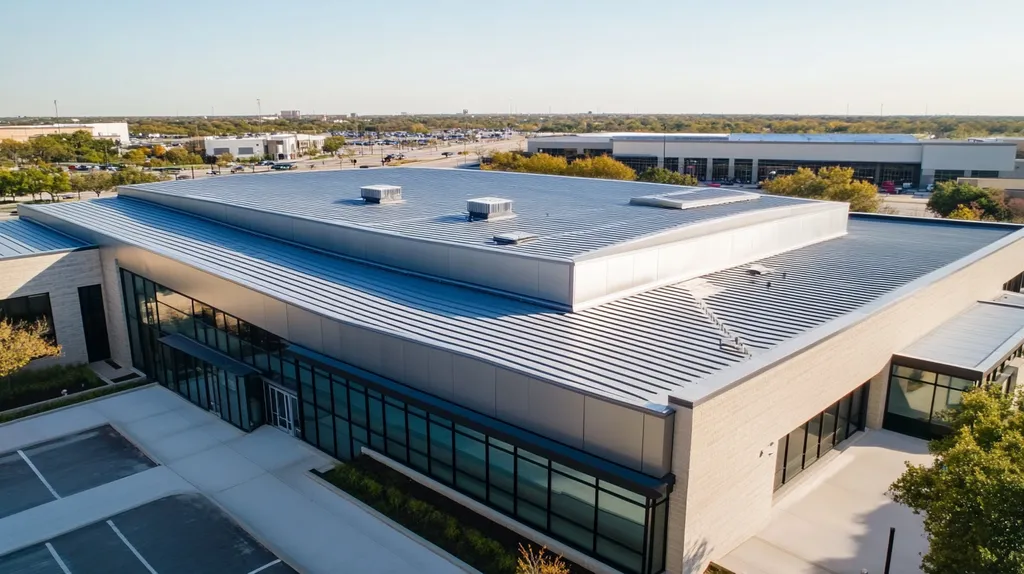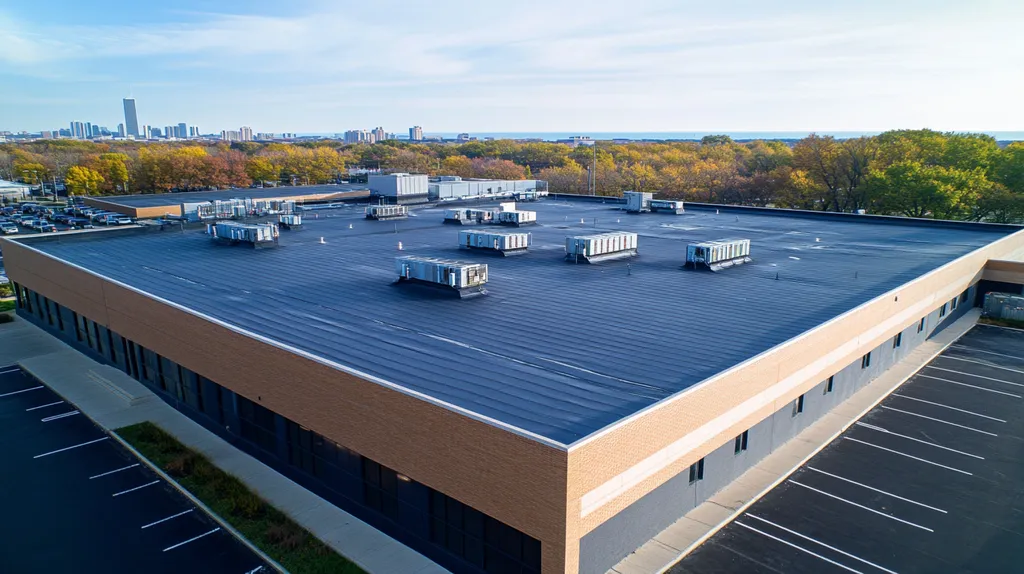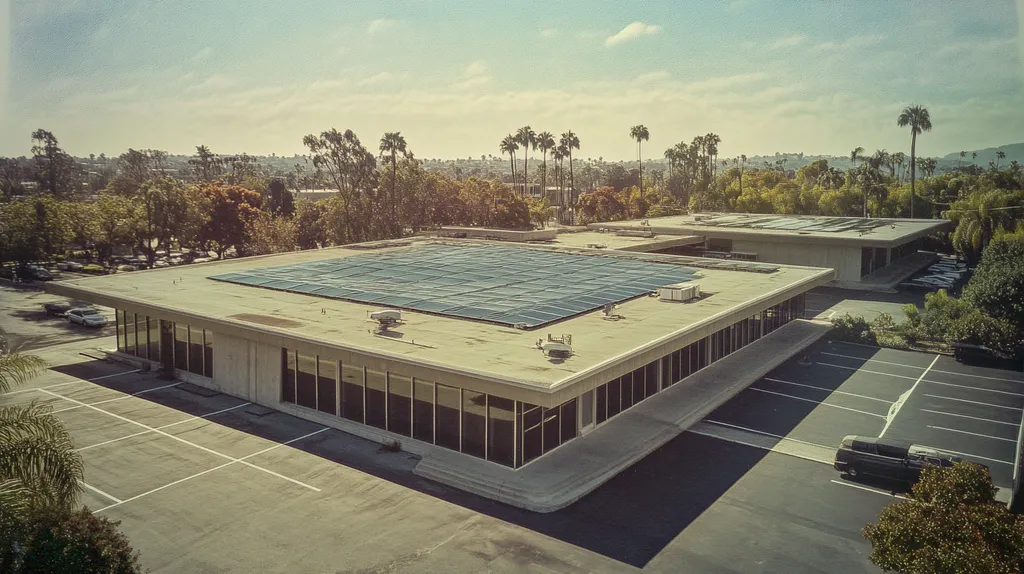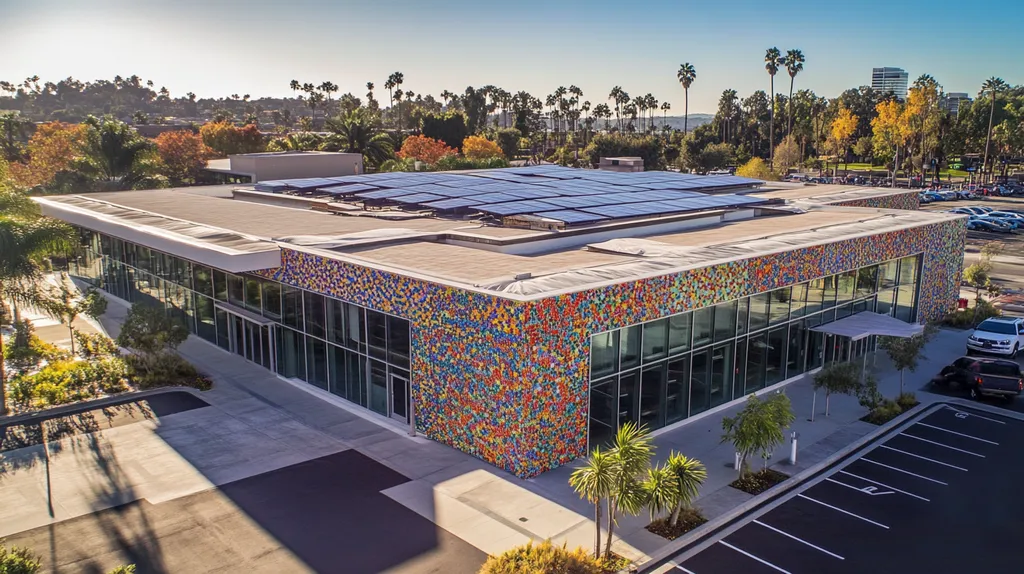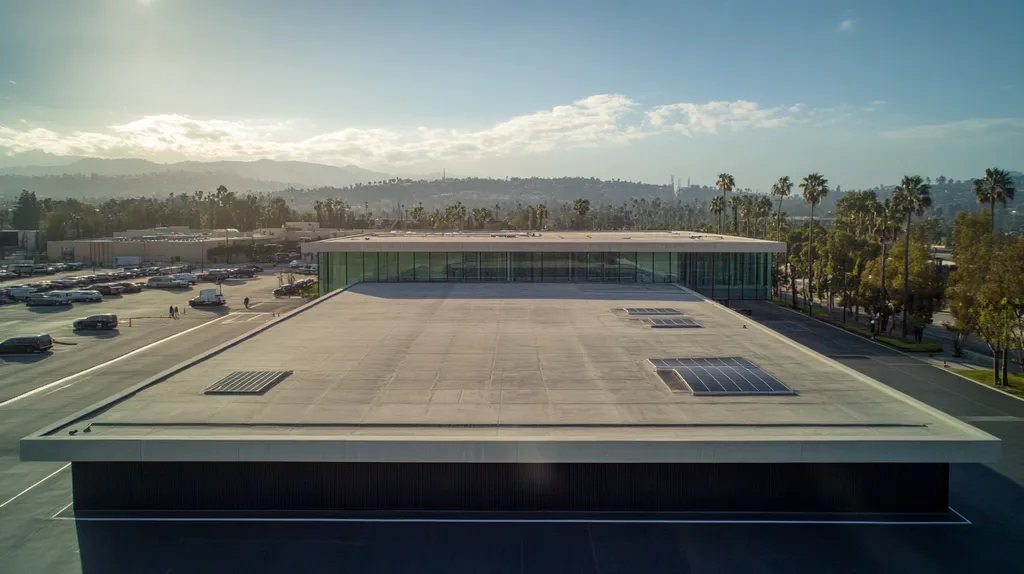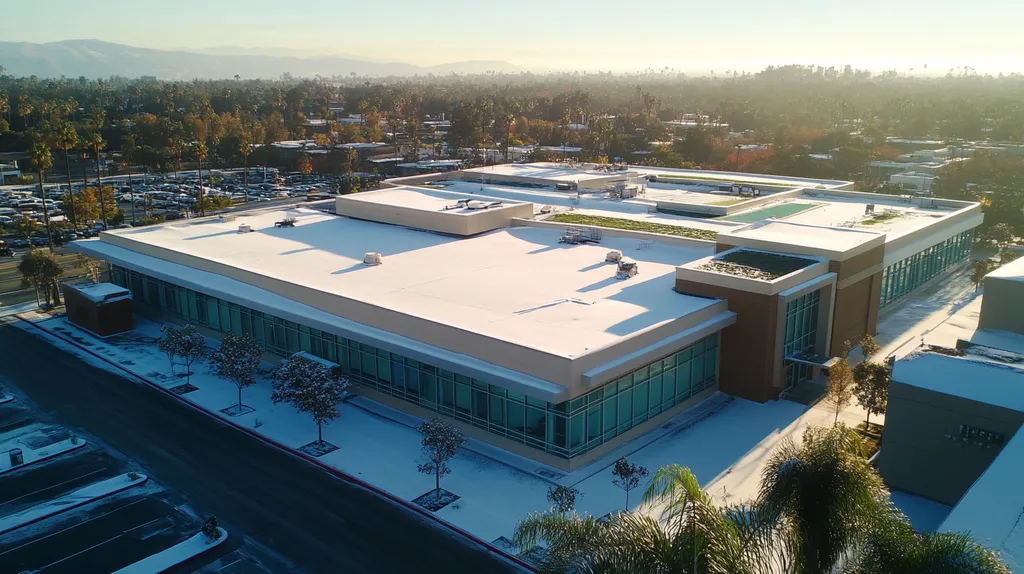Commercial roof installations disrupt business operations for 7-10 days on average, costing facilities thousands in lost productivity and creating preventable safety risks. Industry data shows that 60% of installations exceed planned timelines by 2-3 weeks due to outdated practices and poor coordination.
While modern materials and methods can reduce installation times by up to 50%, most contractors continue using traditional approaches that prioritize construction convenience over business continuity.
This analysis examines how current installation practices create unnecessary operational disruptions and explores data-driven solutions for minimizing business impact while maintaining quality standards.
SECTION 1: CURRENT PRACTICES
Commercial roof installations represent a critical challenge for modern businesses, where every hour of operational disruption directly impacts the bottom line. Traditional installation approaches often prioritize construction efficiency over business continuity, creating unnecessary operational conflicts. When a typical 10,000-square-foot commercial roof installation takes 7-10 business days, the cumulative impact on business operations can be substantial.
Standard Commercial Roof Installation Methods
Modern commercial roofing employs several primary installation methods, each with distinct implications for business operations. Built-up roofing (BUR) systems require multiple installation phases, extending project duration and amplifying operational disruption.
Single-ply membrane systems like TPO and EPDM offer faster installation times but still demand careful staging and execution. These systems typically require large equipment and material staging areas that can impede normal business traffic patterns.
Newer technologies such as spray-applied systems promise reduced installation times but often require more extensive surface preparation. This preparation phase can create additional noise and vibration that affects indoor operations.
The choice of installation method significantly influences both immediate operational impact and long-term maintenance requirements. Each system presents unique challenges for maintaining business continuity during installation.
Typical Project Scheduling and Disruption Factors
According to LiteSpeed Construction, labor shortages in the construction industry have created significant scheduling challenges, with over 300,000 unfilled construction jobs nationwide affecting project timelines. (source: LiteSpeed Construction)
Traditional scheduling approaches often divide projects into rigid phases without considering business peak hours or critical operational periods. This inflexibility can force businesses to alter or suspend operations during crucial revenue-generating times.
Weather delays and material delivery uncertainties frequently extend project durations beyond initial estimates. These schedule changes can cascade through a business’s operational calendar, affecting everything from inventory deliveries to customer appointments.
Most contractors still rely on linear project timelines that fail to account for business-specific needs. This approach often results in unnecessary conflicts between construction activities and essential business functions.
Common Safety and Compliance Protocols
Safety requirements create essential but often overlooked sources of operational disruption. OSHA-mandated safety zones and equipment placement can restrict access to building entrances and parking areas.
Compliance protocols frequently require specific work sequences that extend project duration. These mandatory procedures can prevent contractors from optimizing their workflow around business operations.
Required safety meetings and site inspections often occur during prime business hours. These essential safety activities can interrupt normal business operations and create unexpected delays.
Material storage and handling requirements designed for worker safety can occupy valuable operational space. These safety-mandated arrangements frequently force businesses to modify their normal procedures and traffic patterns.
SECTION 2: SYSTEMIC ISSUES
Commercial roof installations present complex challenges that can severely impact business operations. When systemic issues are not properly addressed, a typical 10,000-square-foot installation can stretch well beyond the standard timeline, creating cascading disruptions throughout the facility. Understanding and planning for these challenges is crucial, as every day of extended installation can cost thousands in lost productivity and potential damage.
Operational Disruptions from Business Continuity Overlaps
The intersection between roofing work and daily operations creates significant challenges for facility managers. Traditional installation schedules often conflict with critical business activities, forcing difficult choices between maintaining operations and completing necessary roof work.
Heavy equipment positioning and material staging frequently block loading docks and emergency exits. These obstacles can force businesses to create temporary workarounds that reduce efficiency and create safety concerns.
Noise and vibration from roofing activities can make office spaces temporarily unusable. Many facilities must relocate staff or adjust work schedules, leading to decreased productivity.
Chemical odors and debris from roofing materials can affect sensitive operations like food processing or electronics manufacturing. These disruptions often require costly containment measures or temporary shutdowns.
Inadequate Weather Contingency Planning Impacts
Weather-related delays represent a major risk factor in commercial roofing projects. Without proper contingency planning, unexpected weather events can leave buildings vulnerable to water damage and extend project timelines significantly.
Emergency weather protection measures often require additional labor and materials not included in initial project estimates. These unexpected costs can strain project budgets and create disputes between facility owners and contractors.
Rapid weather changes can force work stoppages with little notice, leaving partially completed sections exposed. This vulnerability increases the risk of interior damage and can compromise existing waterproofing systems.
The ripple effects of weather delays impact material delivery schedules and crew availability. These scheduling disruptions can extend project completion times well beyond original estimates.
Warranty Risks from Deviations in Installation Practices
Manufacturer warranties require strict adherence to specified installation procedures. Even minor deviations from these requirements can void warranty coverage, leaving facility owners exposed to significant future repair costs.
Pressure to minimize business disruption often leads to rushed installation practices. These shortcuts can compromise roof system performance and create long-term maintenance issues.
Documentation requirements for warranty validation are frequently overlooked during rushed installations. Missing or incomplete documentation can complicate future warranty claims and maintenance planning.
Variations in installation techniques between different crew members can create inconsistent roof system performance. These inconsistencies may not become apparent until well after the installation is complete, complicating warranty claims.
SECTION 3: MISSED OPPORTUNITIES
Commercial roof installations represent critical infrastructure investments that directly impact business performance. Studies show that poorly planned installations can reduce property values by up to 20% while increasing operational costs through energy inefficiency and maintenance issues. Yet many organizations continue to view roofing projects purely as maintenance expenses rather than strategic opportunities for operational enhancement.
Potential Benefits of Phased or Off-Hours Installations
Strategic scheduling of roofing work can dramatically reduce operational disruptions. Phased installations allow businesses to maintain critical operations while systematically replacing roof sections during off-peak hours.
Night and weekend installations minimize impact on daily business activities. This approach particularly benefits retail, manufacturing, and office environments where daytime operations generate primary revenue streams.
Segmented installation planning enables better quality control and more thorough inspection of completed sections. This systematic approach helps ensure proper installation while maintaining warranty compliance.
Coordinated scheduling between roofing crews and facility operations can reduce project duration by up to 30%. This efficiency gain translates directly to reduced operational disruption and faster return to normal business activities.
Energy Efficiency Opportunities Overlooked During Replacement
Modern roofing materials offer significant energy-saving potential that many replacement projects ignore. High-reflectivity membranes can reduce cooling costs by 15-25% in warm climates, while enhanced insulation systems cut heating expenses throughout the year.
Building automation systems can be integrated during roof replacement to optimize energy performance. Smart sensors and monitoring equipment installed during roofing work provide valuable data for ongoing energy management.
Renewable energy integration opportunities are frequently missed during roof replacements. Proper planning can prepare roof structures for future solar installation without requiring additional structural modifications.
Energy-efficient roofing upgrades often qualify for utility incentives and tax benefits. These financial advantages can significantly offset initial installation costs while providing long-term operational savings.
Leveraging Predictive Maintenance to Minimize Downtime
Advanced monitoring systems can detect potential roofing issues before they cause operational disruptions. Moisture sensors, thermal imaging, and regular inspections help prevent unexpected failures that force emergency repairs.
Data-driven maintenance scheduling allows facilities to plan interventions during natural operational downtimes. This proactive approach reduces the need for emergency repairs that can cost 3-5 times more than planned maintenance.
Modern roof management programs use predictive analytics to optimize maintenance timing. These systems help extend roof life while minimizing the impact of maintenance activities on business operations.
Digital documentation of maintenance activities creates valuable data for future planning. This information helps facilities teams make informed decisions about repair timing and replacement scheduling.
SECTION 4: ROOT CAUSES
When commercial roof installations go awry, the impact ripples throughout an organization’s operations. Studies indicate that poorly managed roofing projects can reduce productivity by up to 30% and create safety hazards that put both workers and building occupants at risk. Understanding the fundamental causes of these disruptions is essential for developing effective solutions that protect business continuity while ensuring quality installation.
Fragmented Communication Between Stakeholders
Poor communication between project stakeholders represents one of the most significant barriers to efficient roof installations. When contractors, building managers, and business owners operate in silos, critical information about operational needs and construction requirements gets lost.
Documentation gaps often result in conflicting expectations about project timelines and access requirements. These misunderstandings can lead to unexpected work stoppages and delayed material deliveries that extend project duration.
Many facilities lack standardized communication protocols for managing large-scale roofing projects. Without clear channels for information sharing, stakeholders struggle to coordinate activities and respond to emerging challenges.
Digital project management platforms can help bridge these communication gaps, but many organizations still rely on fragmented communication methods. This resistance to modern collaboration tools often results in preventable delays and coordination failures.
Overreliance on Traditional Installation Timelines
The construction industry’s widespread labor shortages have made traditional installation timelines increasingly unrealistic. With over 300,000 unfilled construction jobs nationwide, standard 7-10 day installation estimates often extend far beyond initial projections. (source: LiteSpeed Construction)
Many contractors continue using outdated scheduling models that fail to account for modern workplace dynamics. These rigid timelines rarely consider the complex operational needs of today’s businesses.
Traditional scheduling approaches often ignore opportunities for parallel work streams that could reduce installation duration. By failing to leverage modern project management techniques, contractors extend disruption periods unnecessarily.
The industry’s resistance to adopting accelerated installation methods compounds these timeline issues. While newer technologies and materials enable faster installations, many contractors stick to familiar but slower methods.
Lack of Integrated Project Planning with Occupant Needs
Project planning frequently occurs without meaningful input from facility occupants and operations managers. This oversight leads to installation schedules that conflict with critical business activities and peak operational periods.
Many roofing projects fail to incorporate flexible work zones that could maintain building access during installation. Instead, contractors often implement blanket access restrictions that create unnecessary operational disruptions.
Storage and staging areas are typically designated based on contractor convenience rather than occupant needs. This approach can block essential access points and disrupt normal business traffic patterns.
Environmental impact considerations, such as noise and odor control, are often afterthoughts in project planning. Without proper mitigation strategies, these factors can render portions of facilities unusable during installation.
DATA DRIVEN EVIDENCE
Commercial roof installations represent significant financial investments where delays and disruptions directly impact business performance. Industry analysis reveals that poorly managed installations can increase project costs by 25-40% while creating operational inefficiencies that persist long after completion. Understanding the relationship between installation methods, environmental factors, and project outcomes is crucial for property owners seeking to minimize disruption while maximizing return on investment.
Analysis of Project Delays and Cost Overruns Statistics
The financial impact of roofing project delays extends far beyond direct construction costs. Current data indicates that 60% of commercial roofing projects exceed their initial timeline estimates by an average of 2-3 weeks.
Each week of delay typically adds 5-8% to the total project cost through increased labor expenses, equipment rental extensions, and material storage fees. These overruns can transform a carefully budgeted project into a significant financial burden.
Insufficient workforce planning remains a primary driver of installation delays. Labor shortages in the construction industry have created significant scheduling challenges, with over 300,000 unfilled construction jobs nationwide affecting project timelines. (source: LiteSpeed Construction)
Material supply chain disruptions compound these workforce challenges, with 45% of projects reporting delays due to unavailable or backordered materials. These delays often create cascading schedule impacts that affect multiple phases of installation.
Correlation Between Disruptions and Installation Techniques
Advanced installation methods demonstrate measurable advantages over traditional approaches. Projects utilizing mechanized installation systems show 30-40% faster completion rates compared to manual installation methods.
Quality metrics also improve with modern techniques. Data indicates that automated welding and precision equipment reduce installation errors by up to 65%, minimizing costly repairs and warranty issues.
Systematic pre-planning and staging techniques reduce operational disruptions by 40% compared to traditional approaches. These improvements directly translate to maintained business productivity during installation.
Modern installation methods enable more precise project scheduling, with 85% of systematically planned projects completing within their revised timeline estimates.
Impact Assessment of Weather and Seasonal Variables
Weather-related delays affect 70% of roofing projects, with precipitation being the leading cause. These delays average 3-5 days per weather event, significantly impacting project timelines and costs.
Seasonal temperature variations influence installation efficiency by 15-25%. Summer heat can reduce worker productivity, while winter conditions often require additional preparation time and specialized procedures.
Regional climate patterns create predictable installation windows that smart scheduling can leverage. Projects planned during optimal weather periods show 40% fewer weather-related delays.
Advanced weather monitoring and prediction tools enable proactive schedule adjustments, reducing the impact of environmental variables by up to 50% when properly implemented.
SECTION 6: ALTERNATIVE SOLUTIONS
Commercial roof installations represent critical infrastructure investments where inefficiencies can cost businesses thousands per day in lost productivity. Traditional approaches often extend projects beyond necessary timeframes, creating preventable disruptions to operations. Modern solutions combining technology, data-driven planning, and innovative materials can reduce installation times by up to 50% while maintaining quality standards. These alternative approaches transform roofing projects from operational disruptions into strategic facility improvements.
Implementing Modular and Prefabricated Roofing Components
Pre-engineered roofing systems dramatically reduce on-site installation time through factory-fabricated components that arrive ready for placement. These systems can cut traditional installation timelines by 40-60% while improving quality control.
Modular components enable precise scheduling of crane operations and material deliveries, minimizing staging area requirements. This precision reduces the footprint of construction activities on facility operations.
Factory fabrication ensures consistent quality across all roofing components while eliminating weather-dependent preparation work. This standardization improves long-term performance and reduces warranty claims.
Advanced manufacturing techniques allow custom modular solutions that accommodate complex roof geometries and penetrations. These specialized components maintain installation efficiency even on technically challenging projects.
Data-Driven Scheduling to Optimize Workflows and Minimize Downtime
Modern project management platforms enable precise coordination between installation crews and facility operations. These systems track multiple variables to identify optimal work windows that minimize business disruption.
Real-time monitoring of weather patterns, material deliveries, and crew availability allows dynamic schedule adjustments. This flexibility helps maintain project momentum while respecting operational constraints.
Digital tracking systems provide stakeholders with accurate progress updates and upcoming activity forecasts. This transparency enables businesses to plan around roofing activities more effectively.
Advanced scheduling algorithms can optimize crew assignments and material staging to maximize productive work hours. These efficiencies translate directly into shorter project durations and reduced operational impact.
Enhanced Training and Technology Adoption for Precision Installation
Investment in crew training on advanced installation techniques pays dividends through faster completion times and fewer errors. Modern training programs combine classroom instruction with hands-on practice using actual roofing systems.
Digital tools like thermal imaging and moisture mapping enable precise pre-installation planning and quality control. These technologies help crews identify and address potential issues before they impact installation progress.
Automated welding and seaming equipment increases installation speed while ensuring consistent quality. This precision reduces the risk of leaks and subsequent repairs that could disrupt operations.
Building Information Modeling (BIM) technology allows virtual project planning that identifies potential conflicts before work begins. This proactive approach prevents unexpected delays and modifications during installation.
Moving Forward
Commercial roof installations continue to cost businesses millions in preventable operational disruptions, with 60% of projects exceeding planned timelines by 2-3 weeks due to outdated practices.
The data clearly shows that traditional installation methods sacrifice business continuity for contractor convenience, creating unnecessary operational losses that impact both short-term revenue and long-term facility performance.
By adopting modern solutions like modular components, data-driven scheduling, and enhanced crew training, facilities can reduce installation times by up to 50% while maintaining quality standards.
The technology and methods exist today to transform commercial roof installations from operational disruptions into strategic facility improvements – the industry must now commit to embracing these proven alternatives.
FREQUENTLY ASKED QUESTIONS
Q. How do commercial roof installations disrupt operations?
A. Commercial roof installations can create significant disruptions, impacting workflow and productivity. Common issues include noise, blocked entrances, and the need to relocate employees. The right planning can help minimize these disruptions and maintain business continuity.
Q. What systemic issues affect commercial roof projects?
A. Systemic issues such as scheduling conflicts can significantly prolong installation times. When project timelines do not consider business operations, disruptions may compound and affect overall facility productivity. Understanding these factors is crucial for successful planning.
Q. What opportunities are missed during commercial roof installations?
A. Many organizations overlook the potential for energy-efficient upgrades during roof replacements. Implementing modern materials can lead to significant cost savings. Recognizing roofing projects as investment opportunities instead of mere maintenance can enhance long-term performance.
Q. How can communication improve commercial roof projects?
A. Improved communication among stakeholders can decrease project disruption. Establishing clear channels for sharing information reduces misunderstandings about timelines and access needs. Using digital tools can enhance collaboration and ensure everyone is on the same page.
Q. What data can drive better commercial roof installations?
A. Analyzing project data reveals that many installations exceed original timelines. Understanding these trends can help facility managers plan better, minimizing costs and disruptions. Data-driven decisions lead to more predictable outcomes and enhanced facility operations.
Q. How can alternative roofing solutions reduce downtime?
A. Utilizing modular and prefabricated roofing components can significantly shorten installation times. These approaches enable efficient scheduling while minimizing disruptions to ongoing operations. Advanced planning and modern materials can transform roofing projects into strategic enhancements.
Q. What are the long-term benefits of strategic roof installation?
A. Strategic planning for roof installations can enhance property value and energy efficiency. Implementing modern materials and technologies ensures improved performance and longevity. This proactive approach reduces overall maintenance costs and improves operational reliability.

